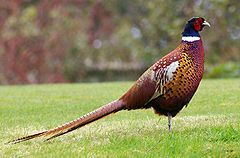- Pheasant
-
Phasianinae 
Mongolian Ringneck-type Common Pheasant cock Scientific classification Kingdom: Animalia Phylum: Chordata Class: Aves Order: Galliformes Family: Phasianidae
Horsfield, 1821Subfamily: Phasianinae
Horsfield, 1821Genus Argusianus
Catreus
Chrysolophus
Crossoptilon
Ithaginis
Lophura
Phasianus
Polyplectron
Pucrasia
Rheinardia
SyrmaticusPheasants refer to some members of the Phasianinae (Horsfield, 1821) subfamily of Phasianidae in the order Galliformes.
Pheasants are characterised by strong sexual dimorphism, males being highly ornate with bright colours and adornments such as wattles and long tails. Males are usually larger than females and have longer tails. Males play no part in rearing the young. Pheasants typically eat seeds and some insects.
The best-known is the Common Pheasant, which is widespread throughout the world in introduced feral populations and in farm operations. Various other pheasant species are popular in aviaries, such as the Golden Pheasant (Chrysolophus pictus).
Contents
Uses of pheasants
Pheasants were traditionally shot for sport and for the table mostly by the upper class elite (e.g., in Britain), and were valued for their attractive appearance. Due to changes in hunting laws this practice has been significantly reduced.
Species in taxonomic order
This list is ordered to show presumed relationships between species
- Blood Pheasant (genus Ithaginis)
- Blood Pheasant, (I. cruentus)
- Koklass (genus Pucrasia)
- Koklass Pheasant, (P. macrolopha)
- Gallopheasants (genus Lophura)
- Kalij Pheasant, (L. leucomelanos)
- White-crested Kalij Pheasant, (L. l. hamiltoni)
- Nepal Kalij Pheasant, (L. l. leucomelanos)
- Black-backed Kalij Pheasant, (L. l. melanota)
- Black Kalij Pheasant, (L. l. moffitti)
- Black-breasted Kalij Pheasant, (L. l. lathami)
- William's Kalij Pheasant, (L. l. williamsi)
- Oates' Kalij Pheasant, (L. l. oatesi)
- Crawfurd's Kalij Pheasant, (L. l. crawfurdi)
- Lineated Kalij Pheasant, (L. l. lineata)
- Silver Pheasant, (L. nycthemera)
- Imperial Pheasant, (L. imperialis)
- Edward's Pheasant, (L. edwardsi)
- Vietnamese Pheasant, (L. hatinhensis)
- Swinhoe's Pheasant, (L. swinhoii)
- Hoogerwerf's Pheasant, (L. hoogerwerfi)
- Salvadori's Pheasant, (L. inornata)
- Crestless Fireback, (L. erythrophthalma)
- Malayan Crestless Fireback, (L. e. erythrophthalma)
- Bornean Crestless Fireback, (L. e. pyronota)
- Crested Fireback, (L. ignita)
- Lesser Bornean Crested Fireback, (L. i. ignita)
- Greater Bornean Crested Fireback, (L. i. nobilis)
- Vieilott's Crested Fireback, (L. i. rufa)
- Delacour's Crested Fireback, (L. i. macartneyi)
- Siamese Fireback, (L. diardi)
- Bulwer's Pheasant, (L. bulweri)
- Kalij Pheasant, (L. leucomelanos)
- Eared Pheasants (genus Crossoptilon)
- White-eared Pheasant, (C. crossoptilon)
- Tibetan Eared Pheasant, (C. harmani)
- Brown Eared Pheasant, (C. mantchuricum)
- Blue Eared Pheasant, (C. auritum)
- Cheer Pheasant (genus Catreus)
- Cheer Pheasant, (C. wallichi)
- Long-tailed Pheasants (genus Syrmaticus)
- Reeve's Pheasant, (S. reevesi)
- Elliot's Pheasant, (S. ellioti)
- Mrs. Hume's Pheasant, (S. humiae)
- Mikado Pheasant, (S. mikado)
- Copper Pheasant, (S. soemmerringi)
- Typical Pheasants (genus Phasianus)
- Green Pheasant (P. versicolor)
- Common Pheasant, (P. colchicus)
- Caucasus Pheasants, Phasianus colchicus colchicus group
- White-winged Pheasants, Phasianus colchicus chrysomelas/principalis group
- Prince of Wales Pheasant, Phasianus colchicus principalis
- Mongolian Ring-necked Pheasants or White-winged Ring-necked Pheasants, Phasianus colchicus mongolicus group
- Tarim Pheasants, Phasianus colchicus tarimensis group
- Chinese Ring-necked Pheasants, Phasianus colchicus torquatus group
- Taiwan Pheasant, Phasianus colchicus formosanus
- Ruffed Pheasants (genus Chrysolophus)
- Golden Pheasant, (C. pictus)
- Lady Amherst's Pheasant, (C. amherstiae)
- Peacock-Pheasants (genus Polyplectron)
- Bronze-tailed Peacock-Pheasant, (P. chalcurum)
- Mountain Peacock-Pheasant, (P. inopinatum)
- Germain's Peacock-Pheasant, (P. germaini)
- Grey Peacock-Pheasant (P. bicalcaratum
- Hainan Peacock-Pheasant, (Polyplectron katsumatae)
- Malayan Peacock-Pheasant, (P. malacense)
- Bornean Peacock-Pheasant, (P. schleiermacheri)
- Palawan Peacock-Pheasant, (P. emphanum)
- Crested Argus (genus Rheinartia)
- Crested Argus, (R. ocellata)
- Great Argus (genus Argusianus)
- Great Argus, (A. argus)
- Double-banded Argus, (Argusianus bipunctatus )
Previous classifications
Euplocamus and Gennceus are older names more or less corresponding to the current Lophura.
- Euplocamus was used, for example, by Hume and Marshall's in their Game Birds of India, Burmah and Ceylon (1879–1881).
- Gennceus, was used, for example, by Frank Finn in Indian Sporting Birds (1915) and Game Birds of India and Asia (1911?).
These old genera were used for:
Vernacular Hume & Marshall Finn: Sporting Birds Finn: Game Birds Contemporary Vieilott's Crested Fireback E. vielloti Lophura rufa (sic) L. ignita rufa Black-backed Kalij E. melanonotus G. melanonotus L. leucomelanos melanota Common or White-crested Kalij E. albocristatus G. albocristatus L. leucomelanos hamiltoni Nepal Kalij E. leucomelanus G. leucomelanus L. leucomelanos leucomelanos Purple, Horsfield's or Black-breasted Kalij E. horsfieldi G. horsfieldi L. leucomelanos lathami Lineated Kalij E. lineatus G. lineatus also: Burmese Silver Pheasant L. leucomelanos lineata Anderson's Silver Pheasant ? G. andersoni, considered hybrid of L. nycthemera and L. l. lineata L. nycthemera andersoni (invalid) Crawfurd's Silver Pheasant (or Crawford's? ) E. andersoni considered a further cross of Anderson's and L. l. lineata ? Crawfurd's Kalij (same as C.'s Silver Pheasant?) ? G. andersoni L. leucomelanos crawfurdi Cuvier's Kalij ? G. cuvieri ? Oates's Kalij ? G. oatesi L. leucomelanos oatesi Whitehead's Silver Pheasant ? G. whiteheadi ? Swinhoe's Kalij ? G. swinhoii L. swinhoii References
- Beebe, William. 1918-22. A Monograph of the Pheasants. 1st edition in 4 volumes: H. F. Witherby, London. Reprint: 1990, Dover Publications.(4 volumes bound as 2). ISBN 0-486-26579-X and ISBN 0-486-26580-3. Republished as: Pheasants: Their Lives and Homes. 2 vols. 1926. Single volume edition: New York Zoological Society, 1936.)
- Green-Armytage, Stephen. 2002. Extraordinary Pheasants.Harry N. Abrams, Inc., New York. Book ISBN 0-8109-1007-1.
- Madge and McGowan, Pheasants, Partridges and Grouse ISBN 0-7136-3966-0
External links
- Videos of pheasants in the Internet Bird Collection
Categories: - Blood Pheasant (genus Ithaginis)
Wikimedia Foundation. 2010.

